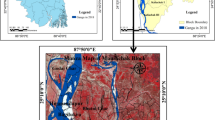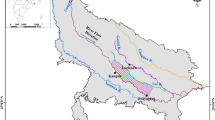Abstract
In this study, sedimentary deposits around the confluence of the Narmada River and its tributary, Orsang River, western India, were studied to understand the confluence dynamics. The results indicate that the sediment sequences exposed at three sites represent the contribution from the Narmada River, the Orsang River and the Heran River at various stages. During the Late Pleistocene, the sedimentation occurred as channel beds and bars in the wider than present and bedload dominant Narmada River. The channel aggradation, shifting and realignment, guided the Orsang River to change its course to flow through the lower course of the Heran River and join the Narmada in response to the early Holocene tectonic activity. High flood flows deposited fine sediments in the channel widening due to tributary confluence and within backflooded Orsang (tributary) valley during mid-late Holocene. The lateral migration of Narmada due to successive high flows during the mid-late Holocene probably led to the downstream movement of the Narmada–Orsang confluence.





Similar content being viewed by others
References
Baker V R and Kochel R C 1988 Flood sedimentation in bedrock fluvial systems; In: Flood geomorphology (eds) Baker V R, Kochel R C and Patton P C, Wiley, USA, pp. 123–137.
Benito G, Sánchez-Moya Y and Sopeña A 2003 Sedimentology of high-stage flood deposits of the Tagus river Central Spain; Sedim. Geol. 157 107–132.
Best J L and Reid I 1984 Separation zone at open channel junctions; J. Hydraul. Eng. 110 1588–1594.
Best J L 1986 The morphology of river channel confluences; Progr. Phys. Geogr. 10 157–174.
Best J L 1988 Sediment transport and bed morphology at river confluences; Sedimentology 35 481–498.
Best J L and Roy A G 1991 Mixing-layer distortion at the confluence of channels of different Depth; Nature 350 411–413.
Best J L and Rhoads B 2008 Sediment transport bed morphology and the sedimentology of river channel confluences; In: River confluences tributaries and the fluvial network (eds) Rice S P, Roy A G and Rhoads B, John Wiley & Sons, Chichester, pp. 45–72.
Bhandari S, Maurya D M and Chamyal L S 2005 Late Pleistocene alluvial plain sedimentation in Lower Narmada valley western India: Palaeoenvironmental implications; J. Asian Earth Sci. 24 433–444.
Biswas S K 1987 Regional tectonic framework structure and evolution of western marginal basins of India; Tectonophys. 135 307–327.
Blair T C and Mcpherson J G 1994 Alluvial fan processes and forms; In: Geomorphology of desert environments (eds) Abrahms A D and Parsons A J ; Chapman & Hall, London, pp. 354–366.
Bridge J S 2003 Rivers and floodplains: Forms processes and sedimentary record; Blackwell Publishers, Oxford, UK.
Chakraborty S and Mukhopadhyay S 2014 A comparative study on the nature of channel confluence dynamics in the lower Jaldhaka River System West Bengal India; Int. J. Geol. Earth Env. Sci. 4 87–97.
Chamyal L S, Maurya D M, Bhandari S and Raj R 2002 Late quaternary geomorphic evolution of the lower Narmada valley Western India: Implications for neotectonics activity along the Narmada-Son Fault; Geomorphology 46 177–202.
Collinson J D and Thompson D B 1982 Sedimentary structures; George Allen and Unwin, London, United Kingdom, ISBN 10:0045520186.
Dixon S J, Sambrook Smith G H, Best J L, Nicholas A P, Bull J M, Vardy M E, Sarker M H and Goodbred S 2018 The planform mobility of river channel confluences: Insights from analysis of remotely sensed imagery; Earth Sci. Rev. 176 1–18.
Ely L L and Baker V R 1985 Reconstructing paleoflood hydrology with slackwater deposits – Verde River Arizona; Phys. Geogr. 6 103–126.
Ely L L, Enzel Y, Baker V R, Kale V S and Mishra S 1996 Changes in the magnitude and frequency of Holocene monsoon floods on the Narmada River Central India; Geol. Soc. Am. Bull. 108 1134–1148.
Ettema R 2008 Management of confluences; In: River Confluences, Tributaries and the Fluvial Network (eds) Rice S P, Roy A G and Rhoads B L, John Wiley and Sons, Chichester, pp. 93–118.
Geological Survey of India 1978 Geological and mineralogical atlas of India Sheet No. 24.
Gupta H, Chakrapani G J, Selvaraj K and Kao S J 2011 The fluvial geochemistry, contributions of silicate, carbonate and saline–alkaline components to chemical weathering flux and controlling parameters: Narmada River (Deccan Traps), India; Geochim. Cosmochim. Acta 75 800–824, https://doi.org/10.1016/j.gca.2010.11.010.
Hackney C R and Carling P A 2011 The occurrence of obtuse junction angles and changes in channel width below tributaries along the Mekong River, south-east Asia; Earth Surf. Process. Landf. 36(12) 1563–1576.
Jain V and Sinha R 2003 Hyperavulsive-anabranching Baghmati river system north Bihar plains eastern India; Z. Geomorphol. 47(1) 101–116.
Juyal N, Chamyal L S, Bhandari S, Maurya D M and Singhvi A K 2004 Environmental changes during Late Pleistocene in the Orsang River basin western India; J. Geol. Soc. India 64 471–479.
Juyal N, Chamyal L S, Bhandari S, Bhushan R and Singhvi A K 2006 Continental record of the southwest monsoon during the last 130 ka: Evidence from the southern margin of the Thar Desert, India; Quat. Sci. Rev. 25 2632–2650.
Kale V S, Ely L A, Enzel Y and Baker V R 1994 Geomorphic and hydrologic aspects of monsoon floods on the Narmada and Tapi rivers in central India; Geomorphology 10 157–168.
Kale V S, Ely L L, Enzel Y and Baker V R 1996 Palaeo and historical flood hydrology Indian Peninsula; In: Global continental changes: The context of palaeohydrology (eds) Branson J, Brown A G and Gregory K J, Geol. Soc. London, Spl. Publ. 115 155–163.
Lama S 2020 Channel confluence dynamics in the lower Chel River System eastern sub-Himalayan West Bengal India; Indian J. Pow. Riv. Val. Dev. 70 93–102.
Maurya D M, Raj R and Chamyal L S 2000 History of tectonic evolution of Gujarat alluvial plains western India during Quaternary: A review; J. Geol. Soc. India 55 343–366.
Miall A D 1977 A review of the braided-river depositional environment; Earth Sci. Rev. 13 1–62.
Miall A D 1996 The geology of fluvial deposits; Springer-Verlag, Berlin, pp. 75–98.
Mosley M P 1976 An experimental study of channel confluences; J. Geol. 84 535–562.
Prizomwala S P, Gandhi D, Bhatt N, Winkler W, Ravi Kumar M, Makwana N and Bhatt N 2018 Geological evidence for AD 1008 tsunami along the Kachchh coast Western India: Implications for hazard along the Makran Subduction Zone; Sci. Rep. 8(1) 1–8.
Raj R 2004 Fluvial response to late Quaternary tectonic changes in the Dhadhar River basin Mainland Gujarat; J. Geol. Soc. India 64 666–676.
Rajaguru S N, Gupta A, Kale V S, Ganjoo R K, Ely L L, Enzel Y and Baker V R 1995 Channel form and processes of the flood-dominated Narmada River India; Earth Surf. Proc. Landf. 20 407–421.
Rhoads B L and Sukhodolov A N 2004 Spatial and temporal structure of shear layer turbulence at a stream confluence; Water Resour. Res. 40 6.
Roy N and Sinha R 2005 Alluvial geomorphology and confluence dynamics in the Gangetic plains, Farrukhabad–Kannauj area, Uttar Pradesh, India; Curr. Sci. 88(12) 2000–2006.
Roy N and Sinha R 2007 Understanding confluence dynamics in the alluvial Ganga–Ramganga valley India: An integrated approach using geomorphology and hydrology; Geomorphology 92 182–197.
Sahu S, Saha D and Dayal S 2015 Sone megafan: A non-Himalayan megafan of craton origin on the southern margin of the middle Ganga Basin India; Geomorphology 250. https://doi.org/10.1016/jgeomorph201509017.
Shit P K and Maity R 2013 Confluence dynamics in an Ephemeral Gully Basin (A case study at Rangamati Paschim Medinipur West Bengal India); Res. J. Appl. Sci. Eng. Tech. 5 3895–3911.
Shukla U K and Singh I B 2004 Signatures of palaeofloods in Sandbar-Levee Deposits Ganga Plain India; J. Geol. Soc. Ind. 64(4) 455–460.
Singh S, Prakash K and Shukla U K 2019 Decadal scale geomorphic changes and tributary confluences within the Ganga River valley in Varanasi region Ganga Plain India; Quat. Int. 507 124–133.
Singh S, Prakash K and Shukla U K 2020 Spatiotemporal migration of the River Ganga in Middle Ganga Plane: Application of remote sensing and GIS technique; J. Ind. Soc. Remote Sens. 48(11) 1495–1507.
Sridhar A 2007a Discharge estimation from planform characters of the Shedhi River Gujarat alluvial plain: Present and past; J. Earth Syst. Sci. 116 341–346.
Sridhar A 2007b A mid-late Holocene flood record from the alluvial reach of the Mahi River Western India; Catena 70 330–339.
Sridhar A and Chamyal L S 2010 Sediment records as archives of the Late Pleistocene-Holocene hydrological change in the alluvial Narmada River Basin Western India; Proc. Geol. Assoc. 121 195–202.
Sridhar A, Chamyal L S and Patel M 2014 Palaeoflood record of high-magnitude events during historical time in the Sabarmati River Gujarat; Curr. Sci. 107 675–679.
Sridhar A, Bhushan R, Balaji D, Band S and Chamyal L S 2016 Geochemical and Sr-Nd isotopic variations in palaeoflood deposits at mainstem – tributary junction western India: Implications on late Holocene flood events; Catena 139 32–43.
Sridhar A, Laskar A, Prasad V, Sharma A, Tripathi J K, Balaji D, Maurya D M and Chamyal L S 2015 Late Holocene flooding history of a tropical river in western India in response to southwest monsoon fluctuations: A multi-proxy study from lower Narmada valley; Quat. Int. 371 181–190.
Sridhar A, Thakur B, Basavaiah N, Seth P, Tiwari P and Chamyal L S 2020 Lacustrine record of high magnitude flood events and climate variability during mid to late Holocene in the semiarid alluvial plains western India; Palaeogeogr. Palaeoclimatol. Palaeoecol. 542 109581.
Subramanian V, Van’t Dack L and Van Grieken R 1985 Chemical composition of river sediments from the Indian subcontinent; Chem. Geol. 48 271–279.
Szupiany R, Amsler M, Parsons D and Best J 2009 Morphology flow structure and suspended bed sediment transport at large braid-bar confluences; Water Resour. Res. 45 W05415.
Tunbridge I P 1984 Facies model for a sandy ephemeral stream and clay playa complex: The Middle Devonian Trentishoe Formation of North Devon UK; Sedimentology 31 697–716.
Zhang Y, Wang P, Wu B and Hou S 2015 An experimental study of fluvial processes at asymmetrical river confluences with hyperconcentrated tributary flows; Geomorphology 230 26–36.
Acknowledgements
This study was part of the Department of Science and Technology sponsored project SR/DST/WOS-A/EA-1017/2015 and EA-22/2019 to Alpa Sridhar and the funding is thankfully acknowledged. The authors thank Dr S Prizomwala, ISR Gandhinagar, for providing OSL chronology on the sample. The grant to the authors under 36th International Geological Congress No. 36th IGC Sectt./Field Trips/2018/20.42 is also thankfully acknowledged.
Author information
Authors and Affiliations
Contributions
AS: Conceptualisation of work, field survey and documentation, data synthesis and interpretation, writing original manuscript. DMM: Data synthesis and interpretation, review and editing of manuscript. LSC: Field survey, interpretation of results, editing of manuscript.
Corresponding author
Additional information
Communicated by George Mathew
Corresponding editor: George Mathew
Rights and permissions
About this article
Cite this article
Sridhar, A., Maurya, D.M. & Chamyal, L.S. Indicators of Holocene high-stage flood events and tributary confluence migration in the lower Narmada Basin, western India. J Earth Syst Sci 131, 219 (2022). https://doi.org/10.1007/s12040-022-01969-z
Received:
Revised:
Accepted:
Published:
DOI: https://doi.org/10.1007/s12040-022-01969-z




